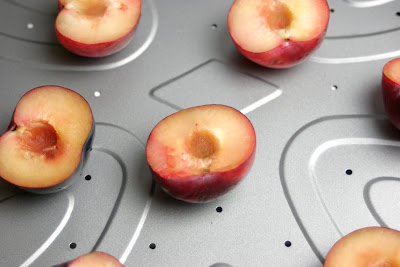
It was only a matter of time before I started trying to dry sliced meat. I was inspired in part by Hugh Fearnley-Whittingstall's book Meat, which I borrowed from my friends. It contains a recipe for bresaola (an Italian cured beef, served thinly-sliced like a continental ham). I saw silverside (a cut of beef we'd usually roast and served sliced in sandwiches, or maybe in a stew, on offer at the local shop, so I got some. But it was far too small for the recipe, so I decided to make jerky.
To be fair, this could just as well be called biltong, or simply dried cured beef. I love that sort of thing, but it is so expensive - a couple of pounds for a tiny packet. It's a fairly guilt-free snack as far as I'm concerned - and this recipe in particular contains no added fat, and the meat isn't very fat to start with. There is a lot of salt and sugar added, but most of that is removed. Nutritional or not, I couldn't find a recipe online that made sense - there were too many proprietary websites - so I decided to improvise.
It worked out so well, I intend to do it again, and I think it's worth posting here. Once again, it can be varied a lot, so I'll include a few ideas along with what I did.
ingredients
- beef (topside, silverside, brisket - fillet is too fine and expensive, and the meat is tenderised by the process, so these tougher cuts are ideal)
- salt
- sugar (I used dark muscovado)
- spices (optional: I used lots of crushed black pepper)
- Worcester sauce (optional: I used mushroom ketchup, which is similar)
method
- If the beef is trussed up, remove the string. You can remove any fat and sinews too, if you like. Wash and pat dry.
- Put the beef in the freezer for an hour or two - until par-frozen.
- Slice the meat thinly with a very sharp knife or a meat slicer. Work quickly - it will start to thaw, and this makes the slicing more difficult.
- Marinate the beef slices. I layered them alternately with salt and sugar, and poured a mixture of more salt and sugar, mushroom ketchup, and freshly-ground black pepper on top. You could use a more liquid marinade, or a dry one. I didn't measure the ingredients - just added enough to cover the meat. Refrigerate for an hour, several hours, or overnight.
- Rinse and pat dry the meat - it should be slightly coloured if you've used dark sugar, molasses, treacle, or Worcester sauce.
- Lay the slices on trays, not touching, and put the trays into an oven, at 40-60ºC, or as low as possible, on the fan setting if it has one.
- Leave them for a long time - at least 6 hours, maybe as long as 24 (depending on the thickness of the slices, and the temperature). When they are dry, leathery, and dark (almost black), they are done - check them, and remove when they are to your liking.
- Refrigerate or freeze, in a sealed jar or plastic container, or eat immediately. They should keep for at least a week at room temperature, possibly much longer - but remember, they will go off eventually (err on the side of caution).
variations and substitutions
I can think of quite a few possibilities off the top of my head, but if I don't include one, don't be put off - experiment. Try different sugars and sweeteners, like honey, maple syrup, or palm sugar. Lots of spices could be included - chilli, Sichuan pepper, five spice, fennel seeds, coriander, garam masala. I don't know if Worcester sauce (or equivalent) is essential - it does add a sharpness, so maybe try a little vinegar instead. Alcohol might work - bourbon or other whiskeys, or possibly brandy might add interest, or red wine, or maybe ale. The dried slices could be smoked, or if you can cold smoke, you could do that before drying them. You can add more seasoning at the end if they are too bland - but taste first, as any flavouring will have become concentrated as the meat dried.






